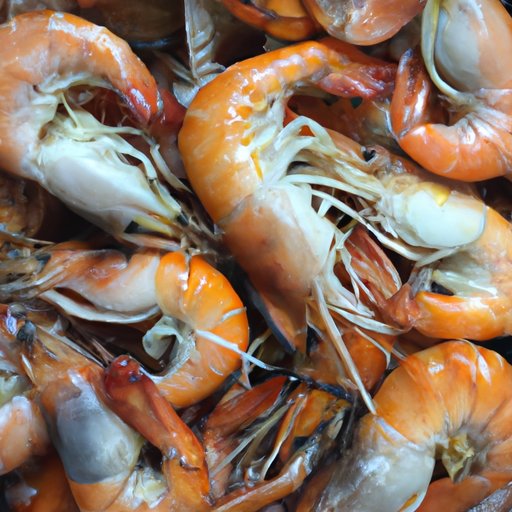
I. Introduction
As seafood enthusiasts, we often indulge in various delicacies made from shrimps, crab, lobster, or other shellfish. While many of us enjoy the meaty flavor and texture, the shells and exoskeletons are often considered byproducts and discarded. But have you ever wondered if you can eat shrimp shells? In this article, we will explore the nutritional value, environmental impact, cultural significance, and creativity of eating shrimp shells.
II. The Pros and Cons of Eating Shrimp Shells: An Analysis of the Nutritional and Edible Value
Shrimp shells have a hard exterior made of chitin, a type of complex carbohydrate that is mostly indigestible. However, the shells also contain a significant amount of protein, vitamins and minerals such as calcium, magnesium, and phosphorus, among others.
While some people consume shrimp shells as a source of calcium or fiber, it is important to note that they can also contain harmful toxins such as mercury and pesticides. Therefore, it is not recommended to regularly eat shrimp shells, especially those from farmed shrimps that are prone to contamination. If in doubt, consult a doctor or dietician before including shrimp shells in your diet.
III. Sustainable Eating: How Eating Shrimp Shells Can Help Reduce Waste
Food waste is a massive environmental issue that affects all levels of society. According to the Food and Agriculture Organization (FAO), roughly one-third of the food produced for human consumption worldwide is lost or wasted every year. This amounts to approximately 1.3 billion tons of food, which is enough to feed all the hungry people in the world over four times.
Eating shrimp shells, along with other food scraps such as vegetable peels or bones, can help reduce food waste and minimize the environmental impact of our consumption habits. Shrimp shells can be boiled to make flavorful broths, used as a seasoning in soups or stews, or even blended and added to smoothies for an extra boost of nutrients.
IV. Culinary Innovations: Creative Recipes You Can Make with Shrimp Shells
Shrimp shells can also be used to create innovative and delectable dishes that showcase their unique texture and flavor. Many chefs and home cooks have experimented with shrimp shells, incorporating them into traditional recipes or creating entirely new dishes.
One of the most popular ways to use shrimp shells is to make a homemade XO sauce, which is a spicy and savory condiment commonly used in Cantonese cuisine. The sauce is made by simmering dried shrimp, garlic, onions, chili peppers and other aromatics with shrimp shells until it forms a thick and fragrant paste.
Another creative use of shrimp shells is to make shrimp chips, which are a crunchy and crispy snack common in Southeast Asian countries. The chips are made by grinding dried shrimp shells into a fine powder, then mixing it with tapioca starch and water to form a dough, which is then deep-fried until crispy.
V. The Fascinating History of Eating Shrimp Shells: A Cultural and Culinary Exploration
Shrimp shells have been eaten by various cultures around the world for centuries, both for their nutritional benefits and cultural significance. In Japan, shrimp shells are used to make a savory broth called “ebi dashi,” which is a staple ingredient in many Japanese dishes such as miso soup and udon noodles.
In some parts of Latin America, grilled or fried shrimp heads are considered a delicacy, and are often served with lime and chili sauce. In China, shrimp shells are believed to have medicinal properties and are used in traditional Chinese medicine to treat various ailments.
VI. Shrimp Shells and Health: How Eating Shrimp Shells Can Benefit Your Body and Mind
While the nutritional benefits of shrimp shells may not be as well-known as other seafood, they do contain several nutrients that are essential for good health. For example, chitin found in shrimp shells has been found to improve gut health by acting as a prebiotic, promoting the growth of good bacteria in the gut.
Shrimp shells also contain antioxidants such as astaxanthin and carotenoids, which have been shown to reduce inflammation and improve brain function. In addition, studies have suggested that shrimp shells may have anti-cancer properties, although more research is needed to confirm this.
VII. Conclusion
Overall, eating shrimp shells can be a fun and creative way to explore new flavors, reduce food waste and enjoy some added nutritional benefits. However, it’s important to be aware of the potential risks and drawbacks of consuming shrimp shells too frequently, especially those from farmed shrimp that may contain harmful toxins. As with any dietary change or experiment, it’s recommended to consult a healthcare professional before making any drastic changes or consuming unfamiliar foods.
If you’re interested in trying some shrimp shell recipes or reducing food waste in your own kitchen, we encourage you to start small and experiment with different flavors and methods.




